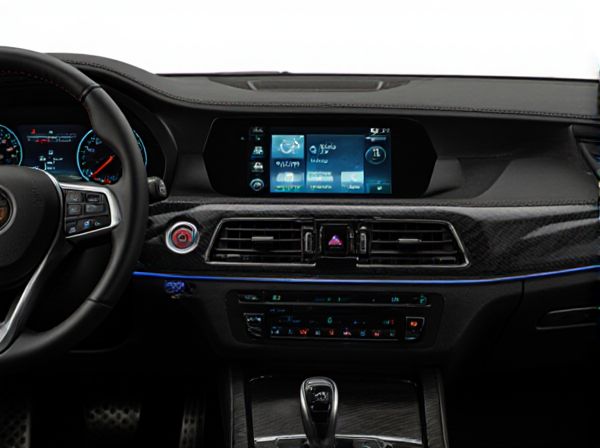
Photo illustration: Physical Button Controls vs Touchscreen Controls
Physical button controls offer tactile feedback and can be easier to operate without looking, enhancing safety and precision. Touchscreen controls provide a sleek, customizable interface that can integrate multiple functions and updates through software. Your choice depends on whether you prioritize tactile responsiveness or flexibility and modern design.
Table of Comparison
| Control Type | Physical Button Controls | Touchscreen Controls |
|---|---|---|
| Usability | Easy to use without looking; tactile feedback | Requires visual attention; no tactile feedback |
| Response Time | Instant, with physical actuation | Potential delay due to system processing |
| Durability | Robust; resistant to wear and tear | Prone to scratches and fingerprint smudges |
| Maintenance | Simple to clean and maintain | Requires frequent cleaning for visibility |
| Customization | Limited to fixed functions | Highly customizable interface and functions |
| Cost | Lower manufacturing costs | Higher development and replacement costs |
| Safety | Minimizes driver distraction | Increases driver distraction risk |
Introduction to Physical and Touchscreen Controls
Physical button controls offer tactile feedback and precise inputs, essential for users who rely on muscle memory and require definitive actuation. Touchscreen controls provide a dynamic interface with customizable layouts that support multi-touch gestures, enhancing interaction flexibility in devices such as smartphones and tablets. Understanding the distinctions between mechanical buttons and capacitive touch sensors is crucial for optimizing user experience in modern electronic gadgets.
Evolution of User Interface Technologies
Physical button controls, foundational in early electronic devices, offer tactile feedback that enhances precision and muscle memory for users. The evolution toward touchscreen controls has introduced versatile interfaces capable of dynamic content display and multitouch gestures, significantly broadening interaction possibilities. This shift reflects advancements in capacitive sensing and display technologies, prioritizing user experience with adaptable, space-saving designs.
Tactile Feedback: The Case for Physical Buttons
Physical button controls provide tactile feedback that enhances user accuracy and confidence by allowing users to feel each press without visual confirmation, reducing operational errors. Unlike touchscreen controls, physical buttons enable intuitive, muscle-memory-based interactions, especially in environments where quick or precise input is critical. This tactile responsiveness is vital in automotive design, industrial equipment, and consumer electronics where safety and efficiency depend on haptic assurance.
Touchscreen Controls: Flexibility and Customization
Touchscreen controls offer unmatched flexibility and customization, allowing users to easily adapt interface layouts to their preferences and needs. These controls enable dynamic updates and software-driven changes without hardware modifications, enhancing user experience through personalized settings, gestures, and multi-function displays. Advanced touchscreens support features like haptic feedback and contextual menus, further increasing interactive efficiency and accessibility in modern devices.
Durability and Maintenance Comparison
Physical button controls offer higher durability due to their robust construction and resistance to accidental damage, making them less prone to wear from repeated use compared to touchscreens. Touchscreen controls, while sleek and versatile, often require more frequent maintenance due to fingerprint buildup, sensitivity issues, and potential screen damage from impacts or scratches. Maintenance costs for physical buttons tend to be lower over time, as replacing individual buttons is simpler than repairing or replacing an entire touchscreen panel.
User Experience and Accessibility
Physical button controls provide tactile feedback that enhances user experience by allowing precise and confident operation, especially for users with visual impairments or limited dexterity. Touchscreen controls offer dynamic interfaces with customizable layouts but may lack tactile cues, potentially hindering accessibility for some users. Designing devices with hybrid options or adaptive features improves inclusivity and usability across diverse user needs.
Speed and Precision in Input Methods
Physical button controls offer faster response times and greater precision due to tactile feedback, enabling users to make accurate inputs without visual confirmation. Touchscreen controls provide versatility but often suffer from slower input speed and less accuracy, especially in fast-paced or detail-oriented tasks. The choice between these input methods hinges on prioritizing speed and precision for specific applications like gaming or professional tools.
Safety and Usability in Real-World Scenarios
Physical button controls provide tactile feedback, allowing drivers to operate functions without diverting their eyes from the road, enhancing safety during driving. Touchscreen controls, while offering a sleek interface and customizable options, often require visual focus, increasing the risk of distraction and delayed reactions. Ergonomic design that combines both physical buttons for critical functions and touchscreens for secondary controls optimizes usability and driver safety in real-world scenarios.
Industry Applications: Automotive, Mobile, and Beyond
Physical button controls in automotive applications offer tactile feedback and reliability essential for driver safety, especially in harsh environments where glove use or vibration can hinder touchscreen accuracy. Mobile devices increasingly favor touchscreen controls for versatile, customizable interfaces, yet physical buttons remain critical for power, volume, and emergency functions, ensuring accessibility and durability. Beyond these sectors, industrial machinery and medical equipment rely on physical buttons for precise, fail-safe operation where touchscreen responsiveness may be compromised by gloves, chemicals, or extreme conditions.
Future Trends in Control Interface Design
Future trends in control interface design emphasize hybrid models combining tactile feedback from physical button controls with the versatility and customization of touchscreen controls to enhance user experience and accessibility. Advances in haptic technology will enable touchscreens to simulate the feel of physical buttons, improving precision and reducing user errors in automotive, consumer electronics, and industrial applications. Integration with AI and adaptive interfaces will allow control systems to learn user preferences, dynamically switching between physical and touchscreen inputs to optimize functionality and safety.
 caratoz.com
caratoz.com